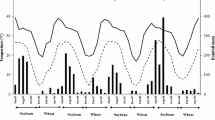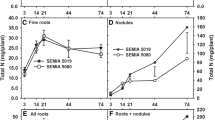Abstract
Nitrogen (N) rhizodeposition by grain legumes such as soybean is potentially a large but neglected source of N in cropping systems of Sub-Saharan Africa. Field studies were conducted to measure soybean N rhizodeposition in two environments of the Guinean savannah of Nigeria using 15N leaf labelling techniques. The first site was located in Ibadan in the humid derived savannah. The second site was in Zaria in the drier Northern Guinean savannah. Soybean N rhizodeposition in the top 0.30 m of soil varied from 7.5 kg ha−1 on a diseased crop in Ibadan to 33 kg ha−1 in Zaria. More than two-thirds of soybean belowground N was contained in the rhizodeposits at crop physiological maturity, while the rest was found in the recoverable roots. Belowground plant-derived N was found to constitute 16–23% of the total soybean N. Taking rhizodeposited pools into account led to N budgets close to zero when all residues were removed. If residues were left in the field or recycled as manure after being fed to steers, soybean cultivation led to positive N budgets of up to +95 kg N ha−1. The role and potential of grain legumes as N purveyors have been underestimated in the past by neglecting the N contained in their rhizodeposits.
Similar content being viewed by others
References
Araujo E S, Boddey RM, Urquiaga S, Alves BJR (2006) Soybean below-ground N and its contribution to the N nutrition of a subsequent sorghum crop. Paper presented at 18th World congress of soil science, Philadelphia, 9–15 July
Bationo A, Traore Z, Kimetu J, Bagayoko M, Bado V, Lompo M, Tabo R, Koala S (2004) Cropping systems in the Sudano-Sahelian zone: implications on soil fertility management. Centro Internacional de Agricultura Tropical (CIAT), Tropical Soil Biology and Fertility (TSBF), Nairobi, p 34
Carsky RJ, Abaidoo R, Dashiell KE, Sanginga N (1997) Effect of soybean on subsequent maize grain yield in Guinea savanna of West Africa. Afr Crop Sci J 5:31–39
Eaglesham ARJ, Ayanaba A, Rao VR, Eskew DL (1982) Mineral N effects on cowpea and soybean crops in a Nigerian soil 2 amounts of N fixed and accrual to the soil. Plant Soil 68:183–192. doi:10.1007/BF02373704
FAO (1988) FAO/UNESCO Soil map of the world, revised legend. World Resources Report 60, FAO, Rome. Reprinted as Technical Paper 20, ISRIC, Wageningen, 1989, p 138
Franke AC, Schulz S, Oyewole BD, Bako S (2004) Incorporating short-season legumes and green manure crops into maize-based systems in the moist Guinean savannah of West Africa. Exp Agric 40:463–479. doi:10.1017/S001447970400211X
Franke AC, Laberge G, Oyewole BD, Schulz S (2008) A comparison between legume technologies, fallow and N-fertilization and their effects on maize and soil traits, in two distinct environments of the West African savannahs. Nutr Cycl Agroecosyst (in press). doi:10.1007/s10705-008-9174-2
Giller KE (2002) Nitrogen fixation in tropical cropping systems. CABI, Wallingford
Giller KE, Witty JF (1987) Immobilized 15N-fertilizer sources improve the accuracy of field estimates of N2-fixation by isotope dilution. Soil Biol Biochem 19:459–463. doi:10.1016/0038-0717(87)90038-1
Harris FMA (1998) Farm-level assessment of the nutrient balance in northern Nigeria. Agric Ecosyst Environ 71:201–214. doi:10.1016/S0167-8809(98)00141-8
Heichel GH (1987) Legume nitrogen: symbiotic fixation and recovery by subsequent crops. In: Helsel ZR (ed) Energy in plant nutrition and pest control. Elsevier, Amsterdam
Hertenberger G, Wanek W (2004) Evaluation of methods to measure differential 15N labelling of soil and root N pools for studies of root exudation. Rapid Comm Mass Spectrom 18:2415–2425. doi:10.1002/rcm.1615
IAEA (2004) Use of isotope and radiation methods in soil and water management and crop nutrition, an interactive CD. IAEA, Vienna
IITA (1981) Analytical services laboratory manual. International Institute of Tropical Agriculture, Ibadan
Khan DF, Peoples MB, Schwenke GD, Felton WL, Chen DL, Herridge DF (2003) Effects of below-ground nitrogen on N balances of field-grown fababean, chickpea, and barley. Aust J Agric Res 54:333–340. doi:10.1071/AR02105
Mayer J, Buegger F, Jensen ES, Schloter M, Hess J (2003) Estimating N rhizodeposition of grain legumes using a 15N in situ stem labelling method. Soil Biol Biochem 35:21–28. doi:10.1016/S0038-0717(02)00212-2
McNeill AM, Zhu CY, Fillery IRP (1997) Use of in situ 15N-labeling to estimate the total below-ground nitrogen of pasture legumes in intact soil–plant systems. Aust J Agric Res 48:295–304. doi:10.1071/A96097
Mitchell RL, Russell WJ (1971) Root development and rooting patterns of soybean (Glycine max (L.) Merrill) evaluated under field conditions. Agron J 63:313–316
Ncube B, Twomlow S, van Wijk M, Dimes J, Giller K (2007) Productivity and residual benefits of grain legumes to sorghum under semi-arid conditions in south western Zimbabwe. Plant Soil 299:1–15. doi:10.1007/s11104-007-9330-5
Ogoke IJ, Carsky RJ, Togun AO, Dashiell K (2003) Effect of P fertilizer application on N balance of soybean crop in the guinea savanna of Nigeria. Agric Ecosyst Environ 100:153–159. doi:10.1016/S0167-8809(03)00183-X
Ojiem J, Vanlauwe B, de Ridder N, Giller K (2007) Niche-based assessment of contributions of legumes to the nitrogen economy of Western Kenya smallholder farms. Plant Soil 292:119–135. doi:10.1007/s11104-007-9207-7
Osunde AO, Bala A, Gwam MS, Tsado PA, Sanginga N, Okojun JA (2003) Residual benefits of promiscuous soybean to maize (Zea mays L.) grown on farmers’ fields around Minna in the southern Guinea savanna zone of Nigeria. Agric Ecosyst Environ 100:209–220. doi:10.1016/S0167-8809(03)00197-X
Polomski J, Kuhn N (2002) Root Research Methods. In: Waisel Y, Eshel A, Kafkafi U (eds) Plant roots the hidden half. Marcel Dekker Inc, New York
Rochester IJ, Peoples MB, Constable GA (1998) Faba beans and other legumes add nitrogen to irrigated cotton cropping systems. Aust J Exp Agric 38:253–260. doi:10.1071/EA97132
Sanginga N, Dashiell K, Okogun JA, Thottappilly J (1997) Nitrogen fixation and N contribution by promiscuous nodulating soybeans in the southern Guinea savanna of Nigeria. Plant Soil 195:257–266. doi:10.1023/A:1004207530131
Sanginga N, Okogun J, Vanlauwe B, Dashiell K (2002) The contribution of nitrogen by promiscuous soybeans to maize based cropping the moist savannah of Nigeria. Plant Soil 241:223–231. doi:10.1023/A:1016192514568
Sanginga N, Dashiell KE, Diels J, Vanlauwe B, Lyasse O, Carsky RJ, Tarawali S, Safo-Adjei B, Menkir A, Schulz S, Singh BB, Chikoye D, Keatinge D, Ortiz R (2003) Sustainable resource management coupled to resilient germplasm to provide new intensive cereal-grain-legume-livestock systems in the dry savanna. Agric Ecosyst Environ 100:305–314. doi:10.1016/S0167-8809(03)00188-9
Schmidtke K (2005) How to calculate nitrogen rhizodeposition: a case study in estimating N rhizodeposition in the pea (Pisum sativum L.) and grasspea (Lathyrus sativus L.) using a continuous 15N labelling split-root technique. Soil Biol Biochem 37:1893–1897. doi:10.1016/j.soilbio.2005.02.024
Schulz S, Carsky RJ, Tarawali SA (2001) Herbaceous legumes: the panacea for West African soil fertility problems? In: Tian G, Keatinge JDH, Ishida F (eds) Sustaining soil fertility in West Africa. SSSA special publication no 58, Madison, pp 179–196
Singh A, Carsky RJ, Lucas EO, Dashiell K (2003) Soil N balance as affected by soybean maturity class in the Guinea savanna of Nigeria. Agric Ecosyst Environ 100:231–240. doi:10.1016/S0167-8809(03)00193-2
Smaling EMA, Nandwa S, Janssen BH (1997) Soil fertility in Africa is at stake. In: Buresh RJ, Sanchez PA, Calhoun F (eds) Recapitalization of soil nutrient capital in Sub-Saharan Africa. ASSA/CSSA/SSSA, Madison
Stoorvogel JJ, Smaling EMA, Janssen BH (1993) Calculating soil nutrient balances in Africa at different scales I. supranational scale. Fert Res 35:227–335. doi:10.1007/BF00750641
Vanlauwe B, Giller KE (2006) Popular myths around soil fertility management in Sub-Saharan Africa. Agric Ecosyst Environ 116:34–46. doi:10.1016/j.agee.2006.03.016
Wichern F, Eberhardt E, Mayer J, Jorgensen RG, Muller T (2008) Nitrogen rhizodeposition in agricultural crops: methods, estimates and future prospects. Soil Biol Biochem 40:30–48. doi:10.1016/j.soilbio.2007.08.010
Yasmin K, Cadisch G, Baggs EM (2006) Comparing 15N-labelling techniques for enriching above- and below-ground components of the plant-soil system. Soil Biol Biochem 38:397–400
Acknowledgments
The authors thank Lekan Tobe, Babatunde Oyewole, Offor Ojikeme and the staff of the head house in IITA Ibadan and of the IITA office in Zaria for their skilled technical assistance. This research was funded by the Faculty of Life Sciences of the University of Copenhagen.
Author information
Authors and Affiliations
Corresponding author
Rights and permissions
About this article
Cite this article
Laberge, G., Franke, A.C., Ambus, P. et al. Nitrogen rhizodeposition from soybean (Glycine max) and its impact on nutrient budgets in two contrasting environments of the Guinean savannah zone of Nigeria. Nutr Cycl Agroecosyst 84, 49–58 (2009). https://doi.org/10.1007/s10705-008-9225-8
Received:
Accepted:
Published:
Issue Date:
DOI: https://doi.org/10.1007/s10705-008-9225-8




